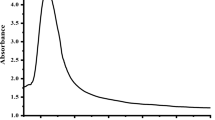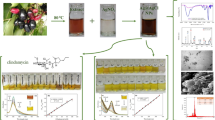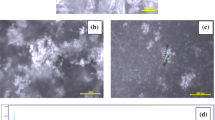Abstract
A low-cost and reliable detection of hydrogen peroxide is essential in the pharmaceutical, medical, and food industries, since H2O2 can cause irreversible cellular damage through the oxidation of biomolecules. This paper describes a sensitive luminescent sensor for H2O2 based on a dual fluorescence-colorimetric assay for determining the hydrogen peroxide using silver nanoparticles prepared with Plinia cauliflora extracts (PcAgNPs). Nanoparticles were characterized by UV–Vis, transmission electron microscopy, elemental analysis, Zeta potential, FTIR, and fluorescence. The average size of spherical particles was ~ 14 nm. The photoreduction process and pH control improved the nanoparticle's photophysical properties and stability. With pH adjustment, the Zeta potential of PcAgNPs prepared with fruit extract changed from ~ − 17 mV to ~ − 30 mV. The behavior of the PcAgNPs SPR and fluorescence bands were studied in the presence of H2O2. The SPR band of PcAgNPs around 420 nm gradually decreased upon the increasing concentration of H2O2, while the PcAgNPs emission has an enhancement and a shift (from ~ 470 to ~ 440 nm) in the presence of hydrogen peroxide. A calibration curve was obtained in the range of 0–5 μM, with a calculated detection limit of 0.15 μM. The present biosensor can be applied as an alternative method for detecting hydrogen peroxide in medical care and environmental monitoring.







Similar content being viewed by others
References
J.P. Ribeiro, L.M. Magalhães, M.A. Segundo, S. Reis, J.L. Lima, Hydrogen peroxide, antioxidant compounds and biological targets: an in vitro approach for determination of scavenging capacity using fluorimetric multisyringe flow injection analysis. Talanta 81(4–5), 1840–1846 (2010). https://doi.org/10.1016/j.talanta.2010.03.049
C.L. Hsu, K.S. Chang, J.C. Kuo, Determination of hydrogen peroxide residues in aseptically packaged beverages using an amperometric sensor based on a palladium electrode. Food Control 19(3), 223–230 (2008). https://doi.org/10.1016/j.foodcont.2007.01.004
R. Gradini, C. Fei, T. Richmund, L. Newlin, A summary on cutting edge advancements in sterilization and cleaning technologies in medical, food, and drug industries, and its applicability to spacecraft hardware. Life Sci. Space Res. 23, 31–49 (2019). https://doi.org/10.1016/j.lssr.2019.05.002
N. Christie-Holmes, R. Tyli, P. Budylowski, F. Guvenc, A. Weiner, B. Poon et al., Vapourized hydrogen peroxide decontamination in a hospital setting inactivates SARS-CoV-2 and HCoV-229E without compromising filtration efficiency of unexpired N95 respirators. Am. J. Infect. Control 49(10), 1227–1231 (2021). https://doi.org/10.1016/j.ajic.2021.07.012
P.V. Mohanan, V. Sangeetha, A. Sabareeswaran, V. Muraleedharan, K. Jithin, U. Vandana et al., Safety of 0.5% hydrogen peroxide mist used in the disinfection gateway for COVID-19. Environ. Sci. Pollut. Res. 28(47), 66602–66612 (2022). https://doi.org/10.1007/s11356-021-15164-y
C.Y.S. Chung, G.A. Timblin, K. Saijo, C.J. Chang, Versatile histochemical approach to detection of hydrogen peroxide in cells and tissues based on puromycin staining. J. Am. Chem. Soc. 140(19), 6109–6121 (2018). https://doi.org/10.1021/jacs.8b02279
A. Abdalla, W. Jones, M.S. Flint, B.A. Patel, Bicomponent composite electrochemical sensors for sustained monitoring of hydrogen peroxide in breast cancer cells. Electrochim. Acta (2021). https://doi.org/10.1016/j.electacta.2021.139314
46th ESAO Congress 3-7 September 2019 Hannover, Germany Abstracts. Int. J. Artif. Organs. 2019;42(8):386–474. https://doi.org/10.1177/0391398819860985
J. Meier, E.M. Hofferber, J.A. Stapleton, N.M. Iverson, Hydrogen peroxide sensors for biomedical applications. Chemosensors. (2019). https://doi.org/10.3390/chemosensors7040064
C.P. Ge, Y. Yan, P.F. Tan, S. Hu, Y.B. **, Y.Y. Shang et al., A NIR fluorescent probe for the in vitro and in vivo selective detection of hydrogen peroxide. Sens. Actuators B Chem. (2022). https://doi.org/10.1016/j.snb.2021.130831
E. Tan, İ Kahyaoğlu, S. Karakuş, A sensitive and smartphone colorimetric assay for the detection of hydrogen peroxide based on antibacterial and antifungal matcha extract silver nanoparticles enriched with polyphenol. Polym. Bull. (Berl.) (2021). https://doi.org/10.1007/s00289-021-03857-w
Z.S. Jie, J. Liu, M.C. Shu, Y. Ying, H.F. Yang, Detection strategies for superoxide anion: a review. Talanta (2022). https://doi.org/10.1016/j.talanta.2021.122892
H. Chu, L. Yang, L. Yu, J. Kim, J. Zhou, M. Li et al., Fluorescent probes in public health and public safety. Coord. Chem. Rev. (2021). https://doi.org/10.1016/j.ccr.2021.214208
V.N. Nguyen, J. Ha, M. Cho, H.D. Li, K.M.K. Swamy, J. Yoon, Recent developments of BODIPY-based colorimetric and fluorescent probes for the detection of reactive oxygen/nitrogen species and cancer diagnosis. Coord. Chem. Rev. (2021). https://doi.org/10.1016/j.ccr.2021.213936
C.R.B. Lopes, D. Santos, F.R.D. Silva, L.C. Courrol, High-sensitivity Hg2+ sensor based on the optical properties of silver nanoparticles synthesized with aqueous leaf extract of Mimusops coriacea. Appl. Phys. A Mater. Sci. Process. (2021). https://doi.org/10.1007/s00339-021-04391-2
D. Sun, D. Yang, P. Wei, B. Liu, Z. Chen, L. Zhang et al., One-step electrodeposition of silver nanostructures on 2D/3D metal-organic framework ZIF-67: comparison and application in electrochemical detection of hydrogen peroxide. ACS Appl Mater Interfaces 12(37), 41960–41968 (2020). https://doi.org/10.1021/acsami.0c11269
S. Teerasong, T. Sonsa-Ard, C. Vimolkanjana, N. Choengchan, A. Chompoosor, D. Nacapricha, Colorimetric sensor using silver nanoparticles for determination of hydrogen peroxide based on a flow injection system. J. Nanoelectron. Optoelectron. 8(5), 446–449 (2013). https://doi.org/10.1166/jno.2013.1506
A. Kalai Priya, G.K. Yogesh, K. Subha, V. Kalyanavalli, D. Sastikumar, Synthesis of silver nano-butterfly park by using laser ablation of aqueous salt for gas sensing application. Appl. Phys. A Mater. Sci. Process. (2021). https://doi.org/10.1007/s00339-021-04370-7
V.V. Apyari, E.A. Terenteva, A.R. Kolomnikova, A.V. Garshev, S.G. Dmitrienko, Y.A. Zolotov, Potentialities of differently-stabilized silver nanoparticles for spectrophotometric determination of peroxides. Talanta 202, 51–58 (2019). https://doi.org/10.1016/j.talanta.2019.04.056
M. Bilal, T. Rasheed, H.M.N. Iqbal, H.B. Hu, X.H. Zhang, Silver nanoparticles: biosynthesis and antimicrobial potentialities. Int. J. Pharmacol. 13(7), 832–845 (2017). https://doi.org/10.3923/ijp.2017.832.845
N.M. Alabdallah, M.M. Hasan, Plant-based green synthesis of silver nanoparticles and its effective role in abiotic stress tolerance in crop plants. Saudi J. Biol. Sci. 28(10), 5631–5639 (2021). https://doi.org/10.1016/j.sjbs.2021.05.081
M. Ghaffari-Moghaddam, R. Hadi-Dabanlou, M. Khajeh, M. Rakhshanipour, K. Shameli, Green synthesis of silver nanoparticles using plant extracts. Korean J. Chem. Eng. 31(4), 548–557 (2014). https://doi.org/10.1007/s11814-014-0014-6
N. Kannan, S. Subbalaxmi, Biogenesis of nanoparticles—a current perspective. Rev. Adv. Mater. Sci. 27(2), 99–114 (2011)
Priya AK, Rao SK, Yogesh GK, Rohini P, Sastikumar D. Green synthesis of Silver Nanoparticles by Pulsed Laser ablation using Citrus Limetta juice extract for Clad-Modified Fiber Optic gas sensing application. Conference on Nanoengineering - Fabrication, Properties, Optics, Thin Films, and Devices XVIII. San Diego, CA (2021)
Priya AK, Sastikumar D. Nano-second Pulsed Laser Ablation and Transformation of Bulk Titanium dioxide (TiO2) into Nano-Particles for Fiber Optic Gas Sensor. 64th DAE Solid State Physics Symposium (DAE-SSPS). Indian inst Technol Jodhpur, Jodhpur, INDIA2019.
C.R. Borges, R.E. Samad, K.D. Goncalves, D.P. Vieira, L.C. Courrol, Interaction between protoporphyrin IX and tryptophan silver nanoparticles. J. Nanopart. Res. (2018). https://doi.org/10.1007/s11051-018-4269-4
Kshirsagar P, Sangaru SS, Malvindi MA, Martiradonna L, Cingolani R, Pompa PP. Synthesis of highly stable silver nanoparticles by photoreduction and their size fractionation by phase transfer method. Colloids and Surfaces A Physicochemical and Engineering Aspects. 2011;392(1):264–70. doi: https://doi.org/10.1016/j.colsurfa.2011.10.003.
C.R.B. Lopes, L.C. Courrol, Green synthesis of silver nanoparticles with extract of Mimusops coriacea and light. J. Lumin. 199, 183–187 (2018). https://doi.org/10.1016/j.jlumin.2018.03.030
D.D. Courrol, C.R.B. Lopes, T.D. Cordeiro, M.R. Franzolin, N.D. Vieira, R.E. Sarnad et al., Optical properties and antimicrobial effects of silver nanoparticles synthesized by femtosecond laser photoreduction. Opt. Laser Technol. 103, 233–238 (2018). https://doi.org/10.1016/j.optlastec.2018.01.044
R.A. de Matos, L.C. Courrol, Biocompatible silver nanoparticles prepared with amino acids and a green method. Amino Acids 49(2), 379–388 (2017). https://doi.org/10.1007/s00726-016-2371-4
K.D. Goncalves, F.R.D. Silva, D.P. Vieira, L.C. Courrol, Synthesis and characterization of aminolevulinic acid with gold and iron nanoparticles by photoreduction method for non-communicable diseases diagnosis and therapy. J. Mater. Sci. Mater. Electron. 30(18), 16789–16797 (2019). https://doi.org/10.1007/s10854-019-01337-6
J.L. Gardea-Torresdey, E. Gomez, J.R. Peralta-Videa, J.G. Parsons, H. Troiani, M. Jose-Yacaman, Alfalfa sprouts: a natural source for the synthesis of silver nanoparticles. Langmuir 19(4), 1357–1361 (2003). https://doi.org/10.1021/la020835i
M. Yilmaz, H. Turkdemir, M.A. Kilic, E. Bayram, A. Cicek, A. Mete et al., Biosynthesis of silver nanoparticles using leaves of Stevia rebaudiana. Mater. Chem. Phys. 130(3), 1195–1202 (2011). https://doi.org/10.1016/j.matchemphys.2011.08.068
V. Gopinath, D. MubarakAli, S. Priyadarshini, N.M. Priyadharsshini, N. Thajuddin, P. Velusamy, Biosynthesis of silver nanoparticles from Tribulus terrestris and its antimicrobial activity: a novel biological approach. Colloids Surf. B Biointerfaces 96, 69–74 (2012). https://doi.org/10.1016/j.colsurfb.2012.03.023
M. Vanaja, G. Annadurai, Coleus aromaticus leaf extract mediated synthesis of silver nanoparticles and its bactericidal activity. Appl. Nanosci. 3(3), 217–223 (2013). https://doi.org/10.1007/s13204-012-0121-9
P.M. Mishra, L. Sundaray, G.K. Naik, K.M. Parida, Biomimetic synthesis of silver nanoparticles by aqueous extract of Cinnamomum tamala leaves: optimization of process variables. Nanosci. Nanotechnol. Lett. 6(5), 409–414 (2014). https://doi.org/10.1166/nnl.2014.1771
S.M. Amini, Preparation of antimicrobial metallic nanoparticles with bioactive compounds. Mater. Sci. Eng. C Mater. Biol. Appl. (2019). https://doi.org/10.1016/j.msec.2019.109809
G. Oza, A. Reyes-Calderon, A. Mewada, L.G. Arriaga, G.B. Cabrera, D.E. Luna, et al., Plant-based metal and metal alloy nanoparticle synthesis: a comprehensive mechanistic approach. J. Mater. Sci. https://doi.org/10.1007/s10853-019-04121-3
M.R. Franzolin, DdSC, SdSB, A.L.C. Courrol, Eugenia uniflora L. silver and gold nanoparticle synthesis, characterization, and evaluation of the photoreduction process in antimicrobial activities. Microorganisms (2022). https://doi.org/10.3390/microorganisms10050999
D.T. Santos, P.C. Veggi, M.A.A. Meireles, Extraction of antioxidant compounds from Jabuticaba (Myrciaria cauliflora) skins: yield, composition and economical evaluation. J. Food Eng. 101(1), 23–31 (2010). https://doi.org/10.1016/j.jfoodeng.2010.06.005
A.D.J. Boari Lima, A.D. Correa, A.P. Carvalho Alves, C.M. Patto Abreu, A.M. Dantas-Barros, Chemical characterization of the jabuticaba fruits (Myrciaria cauliflora Berg) and their fractions. Arch. Latinoam. Nutr. 58(4), 416–421 (2008)
J.C. Baldin, E.C. Michelin, Y.J. Polizer, I. Rodrigues, S.H. Seraphin de Godoy, R.P. Fregonesi et al., Microencapsulated jabuticaba (Myrciaria cauliflora) extract added to fresh sausage as natural dye with antioxidant and antimicrobial activity. Meat Sci. 118, 15–21 (2016). https://doi.org/10.1016/j.meatsci.2016.03.016
T.M. Souza-Moreira, J.A. Severi, E.R. Rodrigues, M.I. de Paula, J.A. Freitas, W. Vilegas et al., Flavonoids from Plinia cauliflora (Mart.) Kausel (Myrtaceae) with antifungal activity. Nat. Prod. Res. 33(17), 2579–2582 (2019). https://doi.org/10.1080/14786419.2018.1460827
G. Mannino, A. Perrone, C. Campobenedetto, A. Schittone, C.M. Bertea, C. Gentile, Phytochemical profile and antioxidative properties of Plinia trunciflora fruits: a new source of nutraceuticals. Food Chem. 307, 8 (2020). https://doi.org/10.1016/j.foodchem.2019.125515
A.G. Junior, P. de Souza, F.A.D. Livero, Plinia cauliflora (Mart) Kausel: a comprehensive ethnopharmacological review of a genuinely Brazilian species. J. Ethnopharmacol. (2019). https://doi.org/10.1016/j.jep.2019.112169
A.D.J. Boari Lima, A.D. Correa, A.A. Saczk, M.P. Martins, R.O. Castilho, Anthocyanins, pigment stability and antioxidant activity in jabuticaba Myrciaria cauliflora (Mart.) O. Berg. Rev. Bras. Frutic. 33(3), 877–887 (2011)
K. Csepregi, M. Kocsis, E. Hideg, On the spectrophotometric determination of total phenolic and flavonoid contents. Acta Biol. Hung. 64(4), 500–509 (2013). https://doi.org/10.1556/ABiol.64.2013.4.10
Z. Jurasekova, J.V. Garcia-Ramos, C. Domingo, S. Sanchez-Cortes, Surface-enhanced Raman scattering of flavonoids. J. Raman Spectrosc. 37(11), 1239–1241 (2006). https://doi.org/10.1002/jrs.1634
M. Hasegawa, M. Terauchil, Y. Kikuchi, A. Nakao, J. Okubo, T. Yoshinaga et al., Deprotonation processes of ellagic acid in solution and solid states. Monatshefte Fur Chemie 134(6), 811–821 (2003). https://doi.org/10.1007/s00706-002-0552-1
D.M. Sampaio, R.S. Babu, H.R.M. Costa, A.L.F. de Barros, Investigation of nanostructured TiO2 thin film coatings for DSSCs application using natural dye extracted from jabuticaba fruit as photosensitizers. Ionics 25(6), 2893–2902 (2019). https://doi.org/10.1007/s11581-018-2753-6
T.K. Patle, K. Shrivas, R. Kurrey, S. Upadhyay, R. Jangde, R. Chauhan, Phytochemical screening and determination of phenolics and flavonoids in Dillenia pentagyna using UV-Vis and FTIR spectroscopy. Spectrochimica Acta Part A Mol. Biomol. Spectrosc. (2020). https://doi.org/10.1016/j.saa.2020.118717
I.O. Faniyi, O. Fasakin, B. Olofinjana, A.S. Adekunle, T.V. Oluwasusi, M.A. Eleruja et al., The comparative analyses of reduced graphene oxide (RGO) prepared via green, mild and chemical approaches. Sn Appl. Sci. (2019). https://doi.org/10.1007/s42452-019-1188-7
A.A. Abdelwahab, Y.B. Shim, Nonenzymatic H2O2 sensing based on silver nanoparticles capped polyterthiophene/MWCNT nanocomposite. Sens. Actuators B Chem. 201, 51–58 (2014). https://doi.org/10.1016/j.snb.2014.05.004
Y. Li, P.P. Zhang, Z.F. Ouyang, M.F. Zhang, Z.J. Lin, J.F. Li et al., Nanoscale graphene doped with highly dispersed silver nanoparticles: quick synthesis, facile fabrication of 3d membrane-modified electrode, and super performance for electrochemical sensing. Adv. Funct. Mater. 26(13), 2122–2134 (2016). https://doi.org/10.1002/adfm.201504533
Z.B. **ang, Y. Wang, P. Ju, D. Zhang, Optical determination of hydrogen peroxide by exploiting the peroxidase-like activity of AgVO3 nanobelts. Microchim. Acta 183(1), 457–463 (2016). https://doi.org/10.1007/s00604-015-1670-x
A. Elgamouz, K. Bajou, B. Hafez, C. Nassab, A. Behi, M. Abu Haija et al., Optical sensing of hydrogen peroxide using starch capped silver nanoparticles, synthesis, optimization and detection in urine. Sens. Actuators Rep. (2020). https://doi.org/10.1016/j.snr.2020.100014
J.S. Liu, Z.Z. Dong, C. Yang, G.D. Li, C. Wu, F.W. Lee et al., Turn-on luminescent probe for hydrogen peroxide sensing and imaging in living cells based on an iridium(III) complex-silver nanoparticle platform. Sci Rep. (2017). https://doi.org/10.1038/s41598-017-09478-6
A. Ruby, M.S. Mehata, Surface plasmon resonance allied applications of silver nanoflowers synthesized from Breynia vitis-idaea leaf extract. Dalton Trans. 51(7), 2726–2736 (2022). https://doi.org/10.1039/d1dt03592d
D. Helena, M.B. Andressa, F.F.A. Celio, M.P. Glaucia, B.B.C. Cinthia, R.M. Mario, Influence of different types of acids and pH in the recovery of bioactive compounds in Jabuticaba peel (Plinia cauliflora). Food Res. Int. 124, 16–26 (2019). https://doi.org/10.1016/j.foodres.2019.01.010
P.W. Connelly, D. Draganov, G.F. Maguire, Paraoxonase-1 does not reduce or modify oxidation of phospholipids by peroxynitrite. Free Radic. Biol. Med. 38(2), 164–174 (2005). https://doi.org/10.1016/j.freeradbiomed.2004.10.010
Y.S. Liu, Y.C. Chang, H.H. Chen, Silver nanoparticle biosynthesis by using phenolic acids in rice husk extract as reducing agents and dispersants. J. Food Drug Anal. 26(2), 649–656 (2018). https://doi.org/10.1016/j.jfda.2017.07.005
N.D. Neves, P.C. Stringheta, I.F. da Silva, E. Garcia-Romero, S. Gomez-Alonso, I. Hermosin-Gutierrez, Identification and quantification of phenolic composition from different species of Jabuticaba (Plinia spp.) by HPLC-DAD-ESI/MSn. Food Chem. (2021). https://doi.org/10.1016/j.foodchem.2021.129605
E. Bulut, M. Ozacar, Rapid, facile synthesis of silver nanostructure using hydrolyzable tannin. Ind. Eng. Chem. Res. 48(12), 5686–5690 (2009). https://doi.org/10.1021/ie801779f
Y.S. Rao, V.S. Kotakadi, T. Prasad, A.V. Reddy, D. Gopal, Green synthesis and spectral characterization of silver nanoparticles from Lakshmi tulasi (Ocimum sanctum) leaf extract. Spectrochimica Acta Part A Mol. Biomol. Spectrosc. 103, 156–159 (2013). https://doi.org/10.1016/j.saa.2012.11.028
S. Rajeshkumar, L.V. Bharath, Mechanism of plant-mediated synthesis of silver nanoparticles—a review on biomolecules involved, characterisation and antibacterial activity. Chem. Biol. Interact. 273, 219–227 (2017). https://doi.org/10.1016/j.cbi.2017.06.019
T.Y. Kim, S.H. Cha, S. Cho, Y. Park, Tannic acid-mediated green synthesis of antibacterial silver nanoparticles. Arch Pharm Res. 39(4), 465–473 (2016). https://doi.org/10.1007/s12272-016-0718-8
F. Tasca, R. Antiochia, Biocide activity of green quercetin-mediated synthesized silver nanoparticles. Nanomaterials (2020). https://doi.org/10.3390/nano10050909
S.N. Barnaby, S.M. Yu, K.R. Fath, A. Tsiola, O. Khalpari, I.A. Banerjee, Ellagic acid promoted biomimetic synthesis of shape-controlled silver nanochains. Nanotechnology 22(22), 225605 (2011). https://doi.org/10.1088/0957-4484/22/22/225605
S.A. Al-Thabaiti, Z. Khan, Biogenic synthesis of silver nanoparticles, sensing and photo catalytic activities for bromothymol blue. J. Photochem. Photobiol 3-4, 100010 (2020). https://doi.org/10.1016/j.jpap.2020.100010
S.L. Smith, K.M. Nissamudeen, D. Philip, K.G. Gopchandran, Studies on surface plasmon resonance and photoluminescence of silver nanoparticles. Spectrochimica Acta Part A Mol. Biomol. Spectrosc. 71(1), 186–190 (2008). https://doi.org/10.1016/j.saa.2007.12.002
Z. Parang, A. Keshavarz, S. Farahi, S.M. Elahi, M. Ghoranneviss, S. Parhoodeh, Fluorescence emission spectra of silver and silver/cobalt nanoparticles. Scientia Iranica 19(3), 943–947 (2012). https://doi.org/10.1016/j.scient.2012.02.026
U. Anik, S. Timur, Z. Dursun, Metal organic frameworks in electrochemical and optical sensing platforms: a review. Microchim. Acta (2019). https://doi.org/10.1007/s00604-019-3321-0
Y.X. Liao, K. Li, M.Y. Wu, T. Wu, X.Q. Yu, A selenium-contained aggregation-induced “turn-on” fluorescent probe for hydrogen peroxide. Org. Biomol. Chem. 12(19), 3004–3008 (2014). https://doi.org/10.1039/c4ob00206g
J.S. Liu, G.N. Liu, W.X. Liu, Y.R. Wang, Turn-on fluorescence sensor for the detection of heparin based on rhodamine B-modified polyethyleneimine-graphene oxide complex. Biosens. Bioelectron. 64, 300–305 (2015). https://doi.org/10.1016/j.bios.2014.09.023
Funding
This work was supported by Grant 303715/2017-0, Conselho Nacional de Desenvolvimento Científico e Tecnológico (CNPq).
Author information
Authors and Affiliations
Corresponding author
Ethics declarations
Conflict of interest
The author(s) declared no potential conflicts of interest concerning the research, authorship, and/or publication of this Article.
Credit authorship contribution statement
LCC: formal analysis, investigation, validation, resources, writing—original draft. KOG and FROS: data colection.
Additional information
Publisher's Note
Springer Nature remains neutral with regard to jurisdictional claims in published maps and institutional affiliations.
Rights and permissions
About this article
Cite this article
de Oliveira Gonçalves, K., Silva, F.R.O. & Courrol, L.C. Low-cost hydrogen peroxide sensor based on the dual fluorescence of Plinia cauliflora silver nanoparticles. Appl. Phys. A 128, 692 (2022). https://doi.org/10.1007/s00339-022-05821-5
Received:
Accepted:
Published:
DOI: https://doi.org/10.1007/s00339-022-05821-5




